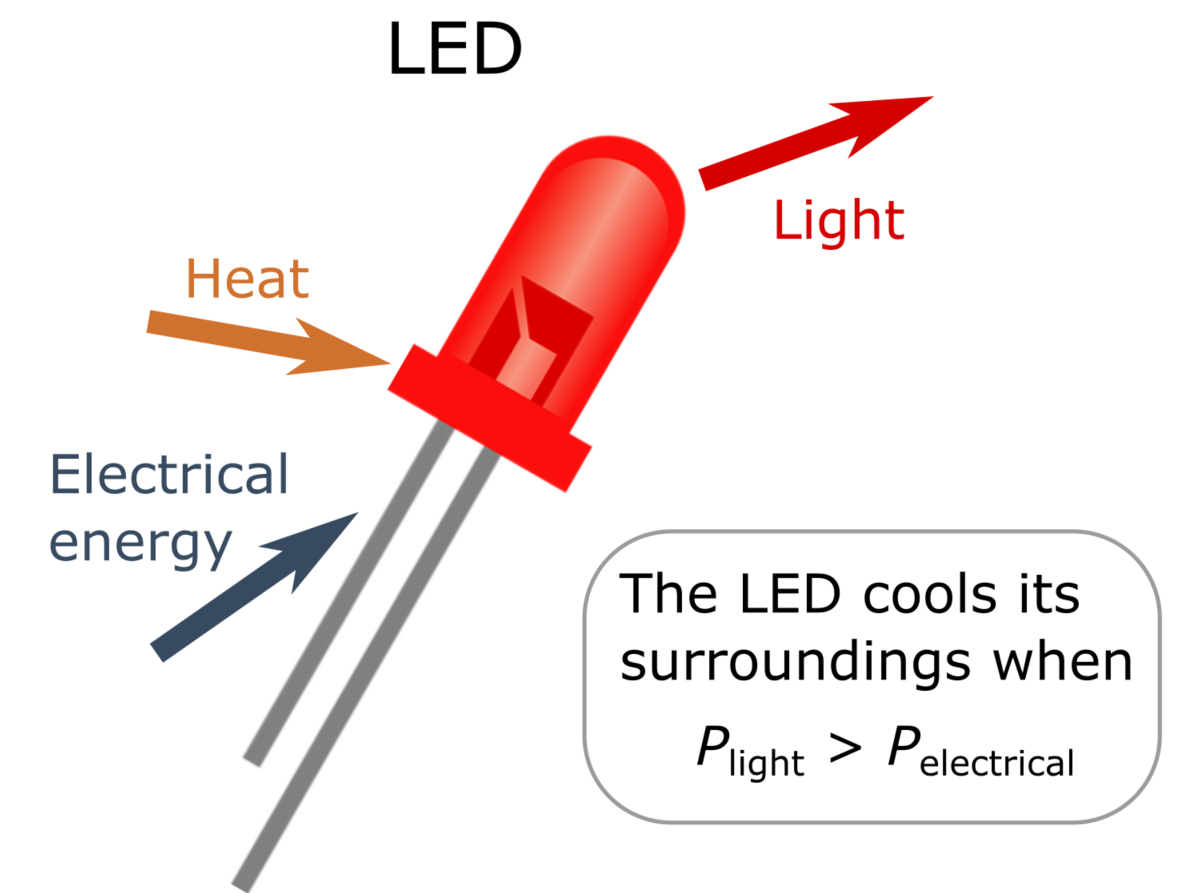Electroluminescent cooling using light-emitting diodes
There is a multitude of areas where sub-zero temperatures are required in space, from the storage of lunar material [1] to the cooling of infrared (IR) cameras and other sensors [2]. Because the transportation of equipment and materials from Earth results in huge costs, with an estimated price of around 500 000 €/kg to the Moon in 2008 [3], lightweight cooling systems are highly sought [1].
For almost 60 years [4], we have known that when an electron-hole pair recombines in certain light-emitting diodes (LEDs), the energy of the emitted photon (light, energy Eout = hν) can exceed the energy of the injected charge carriers (applied current, energy Ein = qV). For this phenomenon, hν qV, to make physical sense, a portion of the energy of the photon must be taken from somewhere - in this case phonons (heat) in the crystal lattice. The result is that the LED can function as a cooling element, drawing heat from the crystal. In this situation, the wall-plug efficiency (WPE), defined as the ratio of the total optical output power to the input electrical power and therefore also called the electrical-to-optical power-conversion efficiency, has a value above unity.
Electroluminescent cooling (ELC) is only feasible, however, if the combined cooling effect from all radiative recombination events exceeds the heating caused by all parasitic, non-radiative recombination events.
For every time an injected electron fails to recombine with a hole or a photon is absorbed in the structure, heat is produced. 
Although the theoretical potential of ELC has been known for a long time [6], it was only recently that ELC was demonstrated in the laboratory - although for extremely low cooling powers [5]. With the increase in the efficiencies of LEDs in general, several groups have started looking into the use of ELC for practical purposes [7-10].
Project overview
In this project, we are working together with researchers from Aalto University [7, 11] on how to make use of this technology in the space sector. LEDs are not highly efficient refrigerators, but they are lightweight, gravity-agnostic, vibrationless, small-footprint, and without any byproduct except light, all of which are of importance for space-based technologies. The focus of this project is on the use of ELC LEDs for refrigeration of vacuum flasks, where a proof-of-concept design is proposed.
Currently, this project is in progress. Further, we are actively investigating areas where this technology might be immediately profitable and other ways to expand on our work.
References:
Sarah Schlieder, "Lunar Deep Freeze Challenge", NASA, 2020, Retrieved 14 July 2021 from www.nasa.gov/lunar-deep-freeze-challenge
J. R. Olson, P. Champagne, E. Roth, T. Nast, E. Saito, V. Loung, A. C. Kenton, and C. L. Dobbins, "Microcryocooler for tactical and space applications", American Institute of Physics Conference Proceedings, Volume 1573(1), Pages 357-364, DOI: 10.1063/1.4860723
D. Schrunk, B. Sharpe, B. L. Cooper, and M. Thangavelu, "The moon: Resources, future development and settlement", Springer Science & Business Media, 2007, DOI: 10.1007/978-0-387-73982-3
G. C. Dousmanis, C. W. Mueller, H. Nelson, and K. G. Petzinger, "Evidence of Refrigerating Action by Means of Photon Emission in Semiconductor Diodes", Physical Review, 1964, Volume 133(1A), Pages A316-A318, DOI: 10.1103/PhysRev.133.A316
P. Santhanam, D. J. Gray Jr., and R. J. Ram, "Thermoelectrically Pumped Light-Emitting Diodes Operating above Unity Efficiency", Physical Review Letters, 2012, Volume 108(9), Pages 097403, DOI: 10.1103/PhysRevLett.108.097403
J. Tauc, "The share of thermal energy taken from the surroundings in the electro-luminescent energy radiated from a p-n junction", Czech Journal of Physics, 1957, Volume 7, Pages 275–276, DOI: 10.1007/BF01688028
I. Radevici, J. Tiira, T. Sadi, S. Ranta, A. Tukiainen, M. Guina, and J. Oksanen, "Thermophotonic cooling in GaAs based light emitters", Applied Physics Letters, 2018, Volume 114(5), Pages 051101, DOI: 10.1063/1.5064786
T. P. Xiao, K. Chen, P. Santhanam, S. Fan, and Eli Yablonovitch, "Electroluminescent refrigeration by ultra-efficient GaAs light-emitting diodes", Journal of Applied Physics, 2018, Volume 123(17), Pages 173104, DOI: 10.1063/1.5019764
J. Xue, Y. Zhao, S.-H. Oh, W. F. Herrington, J. S. Speck, S. P. DenBaars, S. Nakamura, and R. J. Ram, "Thermally enhanced blue light-emitting diode", Applied Physics Letters, 2015, Volume 107(12), Pages 121109, DOI: 10.1063/1.4931365
J. Piprek and Z.-M. Li, "Electroluminescent cooling mechanism in InGaN/GaN light-emitting diodes", Optical and Quantum Electronics, 2016, Volume 48(10), Pages 472, DOI: 10.1007/s11082-016-0729-1
T. Sadi, I. Radevici, and J. Oksanen, "Thermophotonic cooling with light-emitting diodes", Nature Photonics, 2020, Volume 14, Pages 205–214, DOI: 10.1038/s41566-020-0600-6